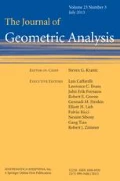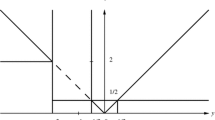Abstract
We characterize the Hardy space \(H^1\) in the rational Dunkl setting associated with the reflection group \(\mathbb {Z}_2^n\) by means of special Riesz transforms. As a corollary we obtain Riesz transforms characterization of \(H^1\) for product of Bessel operators in \((0,\infty )^n\).
Similar content being viewed by others
References
Amri, B., Sifi, M.: Riesz transform for Dunkl transform. Ann. Math. Blaise Pascal 19, 247–262 (2012)
Anker, J-Ph, Ben Salem, N., Dziubański, J., Hamda, N.: The Hardy space \(H^1\) in the rational Dunkl setting. Constr. Approx. 42, 93–128 (2015)
Burkholder, D.L., Gundy, R.F., Silverstein, M.L.: A maximal function characterisation of the class \(H^p\). Trans. Am. Math. Soc. 157, 137–153 (1971)
Coifman, R.R.: A real variable characterization of \(H^p\). Studia Math. 51, 269–274 (1974)
Coifman, R.R., Weiss, G.L.: Extensions of Hardy spaces and their use in analysis. Bull. Am. Math. Soc. 83, 569–615 (1977)
Deleaval, L.: Fefferman-Stein inequalities for the \({\mathbb{Z}}^d_2\) Dunkl maximal operator. J. Math. Anal. Appl. 360, 711–726 (2009)
de Jeu, M.F.E.: The Dunkl transform. Invent. Math. 113, 147–162 (1993)
Dunkl, C.F.: Reflection groups and orthogonal polynomials on the sphere. Math. Z. 197, 33–60 (1988)
Dunkl, C.F.: Differential-difference operators associated to reflection groups. Trans. Amer. Math. 311, 167–183 (1989)
Dunkl, C.F.: Hankel transforms associated to finite reflection groups. In: Proceedings of the Special Session on Hypergeometric Functions on Domains of Positivity, Jack polynomials and applications. Proceedings, Tampa 1991, Contemp. Math., vol. 138, pp. 123–138 (1989)
Dunkl, C.F.: Integral kernels with reflection group invariance. Canad. J. Math. 43, 1213–1227 (1991)
Dziubański, J., Preisner, M., Wróbel, B.: Multivariate Hörmander-type multiplier theorem for the Hankel transform. J. Fourier Anal. Appl. 19, 417–437 (2013)
Evans, L.C.: Partial Differential Equations. Graduate Studies in Mathematics, vol. 19. AMS, Providence, RI (1998)
Fefferman, C., Stein, E.M.: \(H^p\) spaces of several variables. Acta Math. 129, 137–193 (1972)
Macías, R.A., Segovia, C.: A decomposition into atoms of distributions on spaces of homogeneous type. Adv. Math. 33, 271–309 (1979)
Muckenhoupt, B., Stein, E.: Classical expansions and their relation to conjugate harmonic functions. Trans. Am. Math. Soc. 118, 17–92 (1965)
NIST Digital Library of Mathematical Functions. http://dlmf.nist.gov
Opdam, E.M.: Lecture notes on Dunkl operators for real and complex reflection groups. MSJ Memoirs, vol. 8. Mathematical Society of Japan, Tokyo (2000)
Rösler, M.: Generalized Hermite polynomials and the heat equation for Dunkl operators. Commun. Math. Phys. 192, 519–542 (1998)
Rösler, M.: Dunkl operators: theory and applications. In: Orthogonal polynomials and special functions (Leuven, 2002). Lecture Notes in Mathematics, vol. 1817, pp. 93–135. Springer, Berlin (2003)
Rösler, M., Voit, M.: Dunkl theory, convolution algebras, and related Markov processes. In: Harmonic and stochastic analysis of Dunkl processes, Collection Travaux en cours, vol. 71, pp. 1–112. Hermann, Paris (2008)
Stein, E.M., Weiss, G.L.: On the theory of harmonic functions of several variables I (the theory of \(H^p\) spaces). Acta Math. 103, 25–62 (1960)
Stein, E.M.: Singular Integrals and Differentiability of Functions. Princeton University Press, Princeton, NJ (1971)
Stein, E.M.: Harmonic Analysis (Real-Variable Methods, Orthogonality, and Oscillatory Integrals). Princeton Mathematics Series, vol. 43. Princeton University Press, Princeton, NJ (1993)
Thangavelu, S., Xu, Y.: Convolution operator and maximal function for the Dunkl transform. J. Anal. Math. 97, 25–55 (2005)
Uchiyama, A.: A maximal function characterization of \(H^p\) on the space of homogeneous type. Trans. Am. Math. Soc. 262(2), 579–592 (1980)
Watson, G.N.: A Treatise on the Theory of Bessel Functions. Cambridge University Press, Cambridge, MA (1995)
Acknowledgments
The author wishes to thank Jean-Philippe Anker, Paweł Głowacki and Rysiek Szwarc for their remarks. The author is greatly indebted to Bartosz Trojan for his suggestions which shortened the original proof of Theorem 1.3. Finally, the author wants to thank the referee for her/his careful reading of the manuscript and helpful comments which improved the presentation of the paper. Research supported by the Polish National Science Center (Narodowe Centrum Nauki, grant DEC-2012/05/B/ST1/00672) and by the University of Orléans.
Author information
Authors and Affiliations
Corresponding author
Appendix
Appendix
It is well known that
It was proved in [2] that \(h^{\{j\}}_t (x,y)\) has the following global behavior :
From (7.3) we easily conclude that
We shall need the following inequalities for volumes of the Euclidean balls (see [2])
The subordination formula (2.1) combined with (7.1) and (7.2) implies
Lemma 7.1
There is a constant \(C>0\) such that
Moreover, for every \(0<\delta <\frac{1}{\mathbf N}\) there is a constant \(C_\delta \) such that
Proof
To see (7.8) we use (2.1) together with (7.4) and (7.6) and obtain
The proof of the lower bound of \(P_t({\mathbf {x}},{\mathbf {y}})\) is obvious.
In order to prove (7.9) it suffices to consider \(t\le |{\mathbf {x}}|\slash 2\). By (7.6), for every \(\delta >0\) and \(c>0\), we have
Utilizing (7.5) together with (7.10) and proceeding similarly to the proof of (7.8) we have
Fix \(0<\delta <\mathbf {N}^{-1}\). Applying (7.6) we obtain
which proves (7.9). \(\square \)
Proof of Theorem 2.1
The proof, which is in its spirit similar to that of the heat kernel characterization of \(H^1_\mathrm{{atom}}\) (see [2]), is based on the following result due to Uchiyama [26].
Theorem 7.2
Assume that a set X is equipped with
-
a quasi-distance \(\widetilde{d}\) i.e., a distance except that the triangular inequality is replaced by the weaker condition
$$\begin{aligned} \widetilde{d}(x,y)\le A\,\{\widetilde{d}(x,z)+\widetilde{d}(z,y)\}, \qquad \forall \;x,y,z\in X; \end{aligned}$$ -
a measure \(\mu \) whose values on quasi-balls satisfy
$$\begin{aligned} \frac{r}{A}\le \mu (\widetilde{B}(x,r))\le r, \qquad \forall \;x\in X,\,\forall \;r>0\,; \end{aligned}$$ -
a continuous kernel \(K_r(x,y)\ge 0\) such that, for every \(r>0\) and \(x,y,y^{\prime }\in X\),
-
\(K_r(x,x)\ge \frac{1}{Ar}\),
-
\(K_r(x,y)\le r^{-1}\bigl ( 1+\frac{\widetilde{d}(x, y)}{r} \bigr )^{-1-\delta }\) ,
-
\(\bigl | K_r(x,y)-K_r(x,y^{\prime })\bigr |\le r^{-1}\bigl (1+\frac{\widetilde{d}(x, y)}{r}\bigr )^{-1-2\delta } \bigl (\frac{\widetilde{d}(y, y^{\prime })}{r}\bigr )^{\delta }\) when \(\widetilde{d}(y,y^{\prime }) \le \frac{r+\widetilde{d}(x, y)}{4 A}\) .
-
Here \(A\ge 1\) and \(\delta >0\). Then the following definitions of the Hardy space \(H^1(X)\) and their corresponding norms are equivalent :
-
Maximal definition : \(H^1_{\mathrm{max}, K_r}(X)\) consists of all functions \(f\in L^1(X,d\mu )\) such that
$$\begin{aligned} K_*f(x)=\sup \nolimits _{\,r>0}\, \Bigl |{\displaystyle \int _X}K_r(x,y)\,f(y)\,d\mu (y)\Bigr | \end{aligned}$$belongs to \(L^1(X,d\mu )\) and the norm \(\Vert f\Vert _{H^1_{\mathrm{max}, K_r}(X)} = \Vert K_*f\Vert _{L^1(X,d\mu )}\).
-
Atomic definition : An atom for \(H^1_\mathrm{atom}(X,\widetilde{d})\) is a measurable function \(a:X\rightarrow {\mathbb {C}}\) such that: a is supported in a quasi-ball \(\widetilde{B}\), \(\Vert a\Vert _{L^\infty }\lesssim \mu (\widetilde{B})^{-1}\) and \(\displaystyle \int _Xa \,d\mu =0\) (see [5, 15, 26]). Then \(H^1_\mathrm{atom}(X, \widetilde{d})\) consists of all functions \(f\in L^1(X,d\mu )\) which can be written as \(f=\sum _{\ell }\lambda _{\ell } a_{\ell }\), where the \(a_{\ell }\)’s are atoms and \(\sum _{\ell }|\lambda _{\ell }|<+\infty \), and the norm \(\Vert f\Vert _{H^1_\mathrm{atom}(X,\widetilde{d})}= \inf \sum _{\ell }|\lambda _{\ell }|\), where the infimum is taken over all such representations.
For \(X={\mathbb {R}}^n\), equipped with the Euclidean distance \(d(\mathbf {x},\mathbf {y})=|\mathbf {x}-\mathbf {y}|\) and the measure \({\varvec{\mu }}\) (see (1.5)), set
where the infimum is taken over all closed balls B containing \(\mathbf {x}\) and \(\mathbf {y}\). Let \(t=t(\mathbf {x},r)\) be defined by \(\varvec{\mu }(B(\mathbf {x},\sqrt{t}))=r\). Then
and there exists a constant \(c>0\) such that
where \(\widetilde{B}(\mathbf {x},r)=\{ {\mathbf {y}}\in {\mathbb {R}}^n: \widetilde{d}({\mathbf {x}},{\mathbf {y}})<r\}\) (see, e.g., [2]).
Let us remark that thanks to (7.11) and (7.6) the atomic spaces \(H^1_\mathrm{atom}(X,\widetilde{d})\) and \(H^1_\mathrm{atom}\) (defined in Section 1) do coincide and \(\Vert f\Vert _{H^1_\mathrm{atom}(X,\widetilde{d})} \sim \Vert f\Vert _{H^1_\mathrm{atom}}\).
It was proved in [2] that the kernel \({\mathbf {h}}_t\) can be written in the form
where \({\mathbf {H}}_{ t}(\mathbf {x},{\mathbf {y}})\) and \({\mathbf { S}}_{t}(\mathbf {x},{\mathbf {y}})\) are nonnegative continuous functions such that there are \(C_1,\, C_2,\, C_4,\, \delta >0\) such that
for \(\widetilde{d}(\mathbf {y},\mathbf {y}^{\prime })\le C_3\max \,\{ {\varvec{\mu }} (B({\mathbf {x}},\sqrt{t})),\widetilde{d}(\mathbf {x},\mathbf {y})\}\), (the kernel \({\mathbf {S}}_t\) is denoted in [2] by \(\mathbf {P}_t\)). Moreover, the maximal function
is a bounded operator on \(L^1({\mathbb {R}}^n,\, d{\varvec{\mu }} )\).
Using subordination formula (2.1) we write
where
Clearly, the maximal operator
is bounded on \(L^1({\mathbb {R}}^n,\, d{\varvec{\mu }} )\), that is,
\(\square \)
Our task is to prove the following lemma.
Lemma 7.3
There are constants \(C_1,\, C_2,\, C_4,\, \delta ' >0\) such that
for \(\widetilde{d}(\mathbf {y},\mathbf {y}^{\prime })\le C_3\max \,\{ {\varvec{\mu }} (B({\mathbf {x}},t )),\widetilde{d}(\mathbf {x},\mathbf {y})\}\) .
Proof
Take \(0<\delta <\mathbf {N}^{-1}\). By (7.12) and the subordination formula we have
which proves (7.17).
The proof of (7.18) is similar to that of (7.9). Indeed, by (7.13) we have
Now using (7.6) we obtain (7.18).
Now we turn to the proof of (7.19). First we show that there is a constant \(C_4>0\) such that
Since \(U_t({\mathbf {x}},{\mathbf {y}})\le C{\varvec{\mu }} (B({\mathbf {x}},t))^{-1}\) (see (7.18)), it suffices to prove (7.20) for \(\tilde{d}({\mathbf {y}},{\mathbf {y}}')\le {\varvec{\mu }} (B({\mathbf {x}},t))\). Let \(u_0\ge 1\slash 4\) be such that \({\varvec{\mu }}(B({\mathbf {x}},\frac{t}{2\sqrt{u_0}}))=\tilde{d}({\mathbf {y}},{\mathbf {y}}')\). Then, using (7.14) and (7.6), we have
Similarly, by (7.13), we get
Since
(see (7.6)), we obtain (7.20).
We are now in a position to continue the proof of (7.19).
If \(\tilde{d}({\mathbf {x}},{\mathbf {y}})\le {\varvec{\mu }} (B({\mathbf {x}},t))\) then (7.19) follows from (7.20).
If \(\tilde{d}({\mathbf {x}},{\mathbf {y}})>{\varvec{\mu }} (B({\mathbf {x}},t))\) and \(\tilde{d}({\mathbf {y}},{\mathbf {y}}') <\tilde{d}({\mathbf {x}},{\mathbf {y}})\slash (2A)\), then \(\tilde{d}({\mathbf {x}},{\mathbf {y}})\le 2A\tilde{d} ({\mathbf {x}},{\mathbf {y}}')\). Hence, from (7.18) we conclude that
Consequently, we deduce (7.19) (with perhaps small \(\delta '>0\)) from (7.20) and (7.21).
It remains to consider the case when \(\tilde{d}({\mathbf {x}},{\mathbf {y}}) > {\varvec{\mu }} (B({\mathbf {x}},t))\) and \(\tilde{d}({\mathbf {y}},{\mathbf {y}}') \ge \tilde{d}({\mathbf {x}},{\mathbf {y}})\slash (2A)\). Recall that \(\tilde{d}({\mathbf {y}},{\mathbf {y}}')\le {\varvec{\mu }} (B({\mathbf {x}},t))\). Thus \(\tilde{d}({\mathbf {x}},{\mathbf {y}})\sim {\varvec{\mu }} (B({\mathbf {x}},t))\). So, finally, using (7.20) we have
This completes the proof of Lemma 7.3. \(\square \)
Set \(K_r({\mathbf {x}},{\mathbf {y}})=U_t({\mathbf {x}},{\mathbf {y}})\), where \(r={\varvec{\mu }} (B({\mathbf {x}},t))\). Now Theorem 2.1 follows from (7.15), boundedness of the maximal function \(W_*\) on \(L^1({\mathbb {R}}^n, {\varvec{\mu }})\), and the Uchiyama theorem (see Theorem 7.2) combined with Lemma 7.3.
Now we turn to prove (2.4). Recall that \(P_t({\mathbf {x}},{\mathbf {y}})>0\). So, by (7.7), the operator \(P_*\) is bounded on \(L^\infty ({\mathbb {R}}^n, d{\varvec{\mu }})\). Thanks to (7.18) and (7.16), it is of weak-type (1,1). Finally, from the Marcinkiewicz interpolation theorem we conclude that \(P_*\) is bounded on \(L^p({\mathbb {R}}^n,\, d{\varvec{\mu }})\) for \(1<p<\infty \). \(\square \)
Proof of Proposition 2.2
Fix \(\varepsilon >0\). There is \(R>0\) such that \(|g({\mathbf {x}})|<\varepsilon \) for \(|{\mathbf {x}}|>R\). Write
From (7.7) we get \(|P_tg_2({\mathbf {x}})|<\varepsilon \) for every \(t>0\) and \({\mathbf {x}}\in {\mathbb {R}}^n\). Now using (7.8) we obtain
On the other hand, if t remains in a bounded interval and \(|{\mathbf {x}}|>2nR\), applying (7.9) we have
The proof of the first part of Proposition 2.2 is complete.
In order to prove the second part of the proposition we fix \(\varepsilon >0\). We claim that
To prove the claim let \(\varepsilon ' >0\). Take \(R>0\) large enough such that \(\int _{|{\mathbf {y}}|>R} |f({\mathbf {y}})|\, d{\varvec{\mu }} ({\mathbf {y}})\le \varepsilon ' {\varvec{\mu }}(B(0, \varepsilon ))\). Write \(f=f\chi _{B(0,R)}+f\chi _{B(0,R)^c}=:f_1+f_2\). Then, by (7.7) and (7.8) we have \(|P_\varepsilon f_2|\le \varepsilon '\). On the other hand from the first part of the proposition we conclude that \(\lim _{|{\mathbf {x}}|\rightarrow \infty } P_\varepsilon f_1({\mathbf {x}})=0\), which gives the claim. Now (2.5) follows from the first part of Proposition 2.2, since \(P_{t+\varepsilon } f=P_t(P_\varepsilon f)\). \(\square \)
Rights and permissions
About this article
Cite this article
Dziubański, J. Riesz Transforms Characterizations of Hardy Spaces \(H^1\) for the Rational Dunkl Setting and Multidimensional Bessel Operators. J Geom Anal 26, 2639–2663 (2016). https://doi.org/10.1007/s12220-015-9642-2
Received:
Published:
Issue Date:
DOI: https://doi.org/10.1007/s12220-015-9642-2



